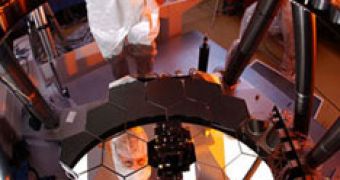Named in 2002, after NASA's second administrator, James Webb Space Telescope (JWST) is a planned space infrared observatory, which will be created as an improvement of the aging Hubble Space Telescope. The telescope is planned to be launched in 2013, from an Ariane 5 rocket, and is the result of the collaboration between NASA, the European Space Agency and the Canadian Space Agency.
The primary mission of the future space telescope, will be to search light from forming stars and galaxies after the Big Bang, the study and evolution of galaxies, the understanding of the stars and planetary systems and the study of the origin of life.
The JWST will be placed in space at a location called Sun-Earth L2 Lagrange point, meaning that the Earth and the Sun will occupy relatively the same position in the telescope's view. The future telescope will have a reflective collective area six times larger than Hubble's, and will operate in the infrared spectrum.
NASA is currently experimenting the possibility of integrating in JWST, a new advanced technology network interface called "SpaceWire", originally developed by the European Space Agency, "SpaceWire" enables high speed communication between different components of the telescope. The newly designed microchips will have the capability of sending and receiving information at rates as high as 200 megabits per second.
NASA says that they will also incorporate a series of microshutters, that will have the same role as the eyelashes have, blocking part of the unnecessary bright light shining toward the telescope's detector, so it can detect the faint light coming from very distant objects.
The high speed of the "SpaceWire" technology, will enable the possibility to use extremely high resolution detectors, such as that planned for JWST of sixty-six million pixels detector, which means that better picture of distant objects will be made, to better understand the universe.
Goddar's technology is now used in deferent US aerospace projects, by NASA and other government laboratories.
The future JWSP will be able to look as far as 13 billion light years away, to observe the galaxy's and the stars' formation, and will be launched in 2013, having an estimated cost of the project of about 4.5 billion USD.

 14 DAY TRIAL //
14 DAY TRIAL //